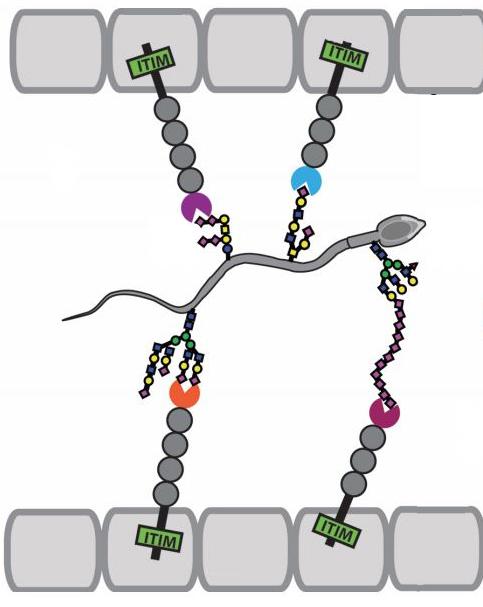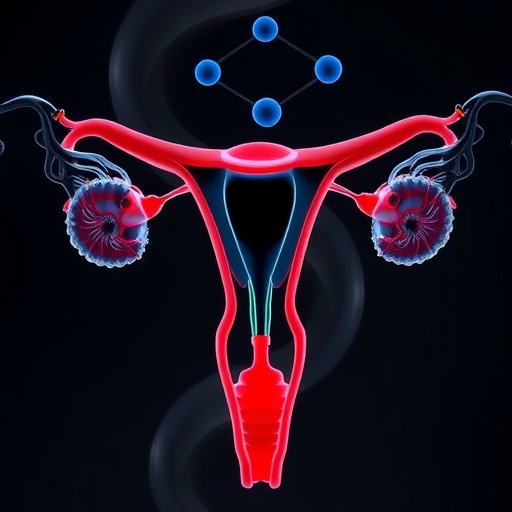Researchers discover endometrial receptor that can recognize sperm molecule

Credit: (c) American Society for Biochemistry and Molecular Biology
Why does it take 200 million sperm to fertilize a single egg?
One reason is that sperm, when they arrive in the uterus, face a bombardment by the immune system. Perhaps, says molecular anthropologist Pascal Gagneux, many are needed so that some will survive. On the other hand, there may be a benefit to culling so many sperm.
“I’m a lonely zoologist in a medical school,” Gagneux said. “My elevator spiel is that all of life is one big compromise. [For an egg], being too easy to fertilize is bad; being too difficult to fertilize is also bad.”
Gagneux’s lab at the University of California, San Diego, has discovered the makings of a “secret handshake” between sperm and the cells lining the uterus. Uterine cells, they report in the Journal of Biological Chemistry, express a receptor that recognizes a glycan molecule on the surface of sperm cells. It’s possible that this interaction may adjust the female’s immune response and help sperm make it through the leukocytic reaction.
The leukocytic reaction is not well understood. What we do know, Gagneux explained, is that “after crossing the cervix, millions of sperm — a U.S. population worth of sperm — that arrive in the uterus are faced by a barrage of macrophages and neutrophils.”
This attack by the innate immune system kills a majority of the sperm cells in semen, winnowing hundreds of millions of sperm down to just a few hundred that enter the fallopian tubes. The defensive response may be beneficial in preventing polyspermy, when an egg is fertilized by more than one sperm and cannot develop.
Because sperm are coated in sialic acid-rich glycans, and the innate immune system uses sialic acid to differentiate human cells from invaders, Gagneux and his lab initially expected that the glycan might be involved in interactions with innate immune cells called neutrophils. But neutrophils they tested did not seem to see much difference between sperm with and without sialic acid.
Meanwhile, the team observed sialic acid binding receptors called siglecs on endometrial cells. In solution, these endometrial receptors can bind to whole sperm. According to Gagneux, the binding interaction may help the sperm run this gantlet–for example, by dampening the immune response. Alternatively, it may be a way for uterine cells to weed out faulty sperm. In the immune system, this receptor class helps cells to recognize sialic acid molecules as “self,” and in that context they can either turn up or down inflammation.
“It’s somewhat embarrassing how little we can say about what this [interaction] means,” he said. The first step in understanding its physiological significance will be to look for direct interaction between sperm and intact uterine tissue–this paper looked at only sperm interacting with purified proteins.
In some ways, Gagneux added, it’s humbling to be working in such a poorly understood area. Reproduction, he said, “is a very, very delicate tug-of-war at many levels. The fact that there is (also) this immune game going on is completely fascinating.”
###
DOI: jbc.RA119.008729
This study was supported by NIH (GM1R01GM095882 and K12GM068524), the Mitzutani Foundation for Glycosciences, and the G Harold and Leila Y Mathers Foundation.
Other authors of this study include Eillen Tecle, Hector Sequoyah Reynoso and Ruixuan Wang.
About the Journal of Biological Chemistry
JBC is a weekly peer-reviewed scientific journal that publishes research “motivated by biology, enabled by chemistry” across all areas of biochemistry and molecular biology. To read the latest research in JBC, visit http://www.
Media Contact
Laurel Oldach
[email protected]
Related Journal Article
http://dx.




